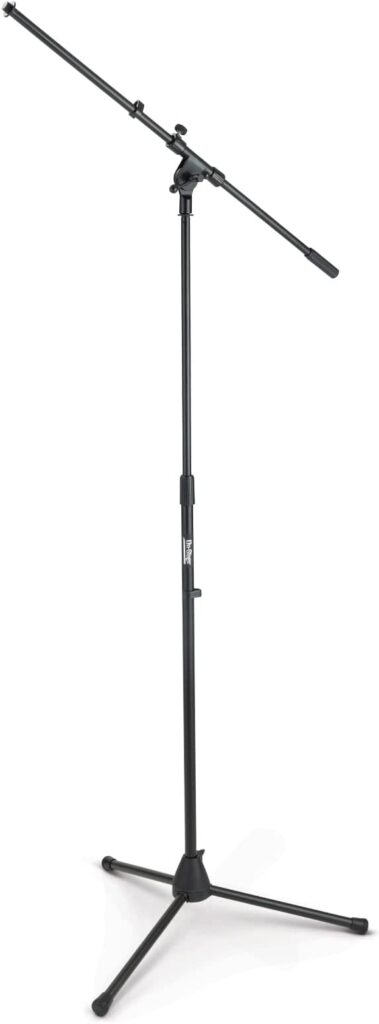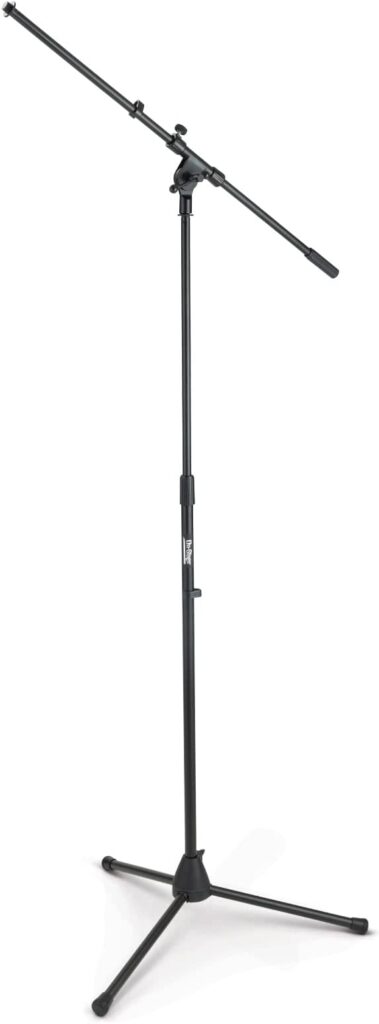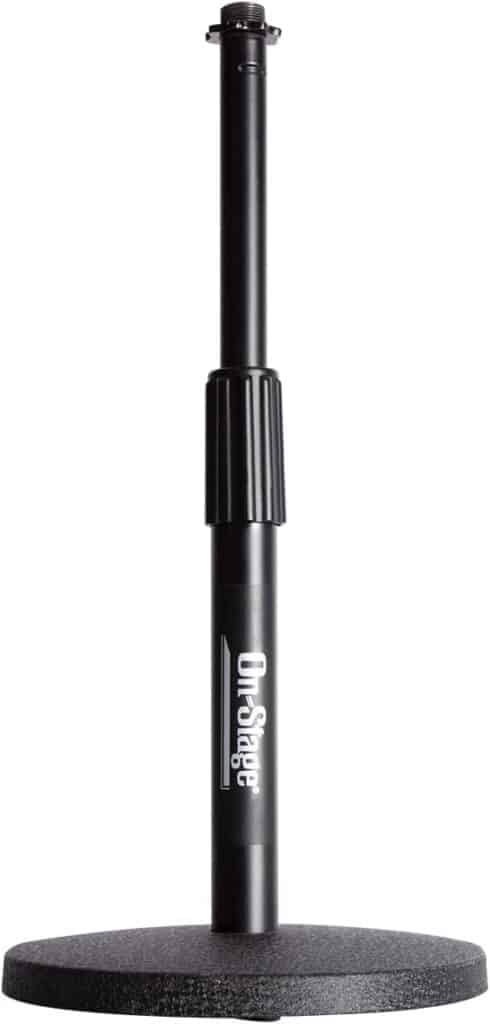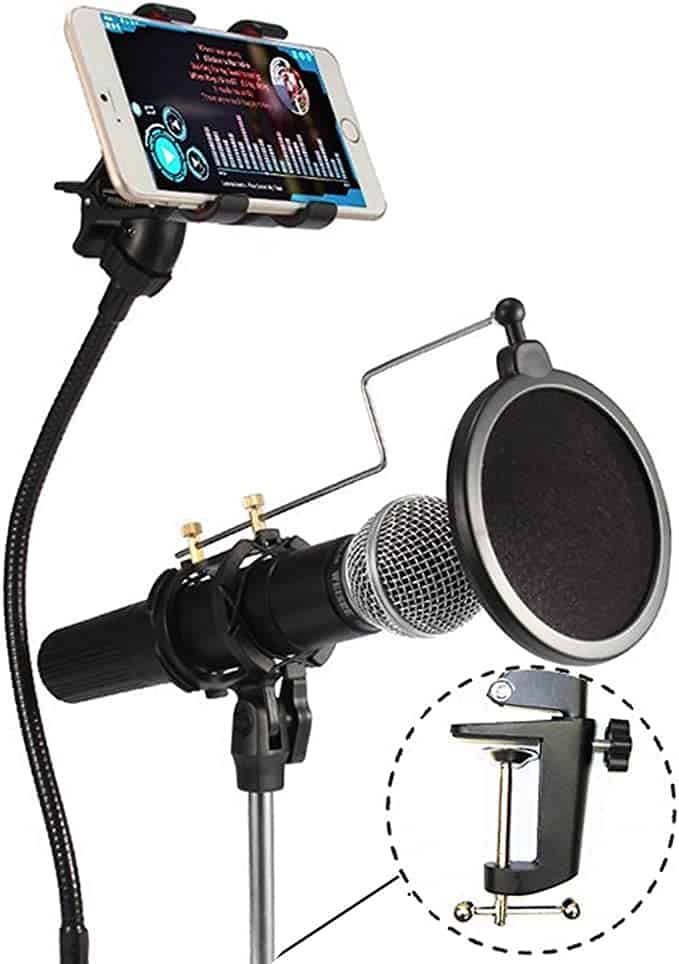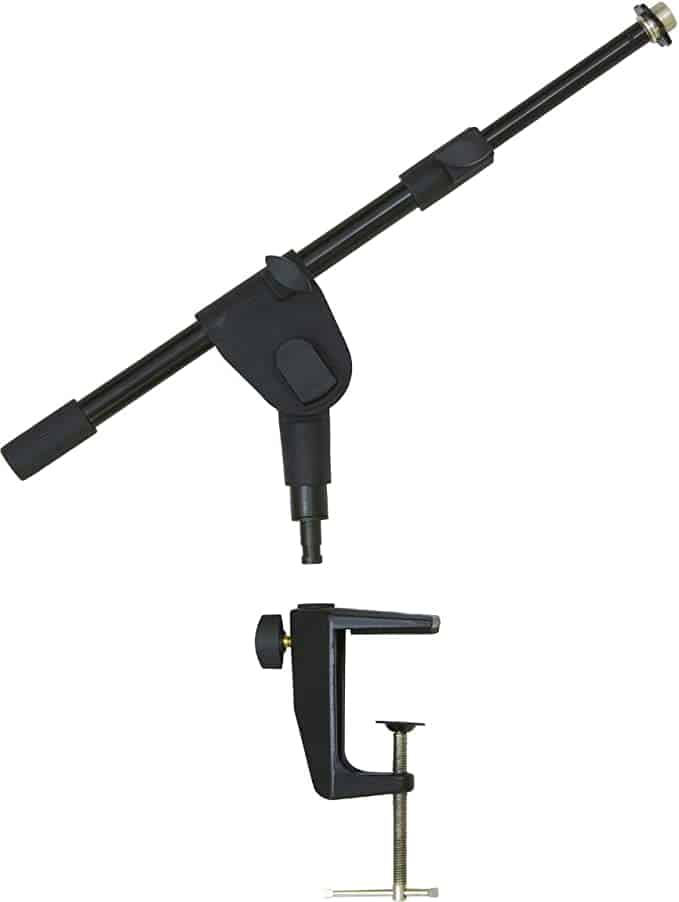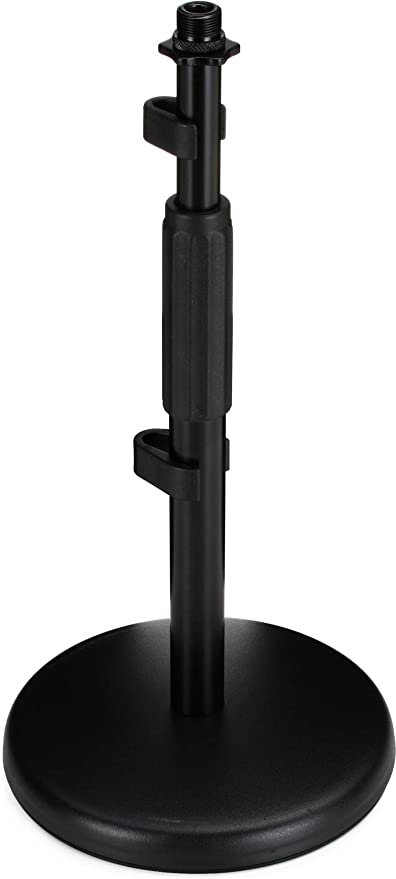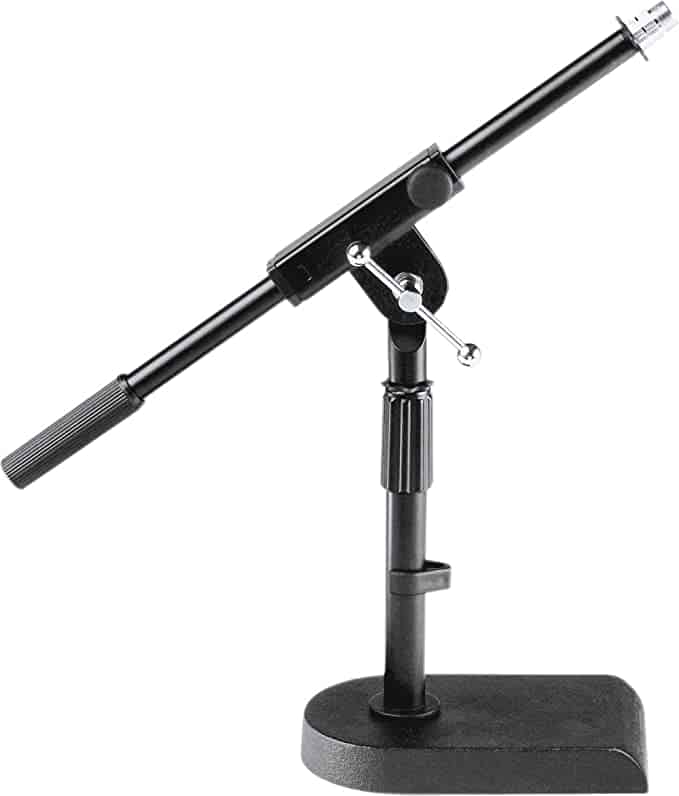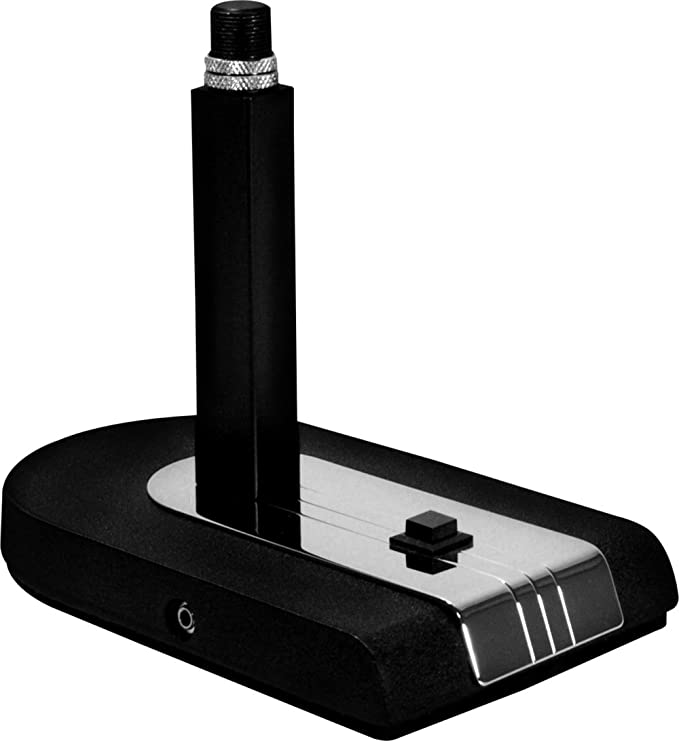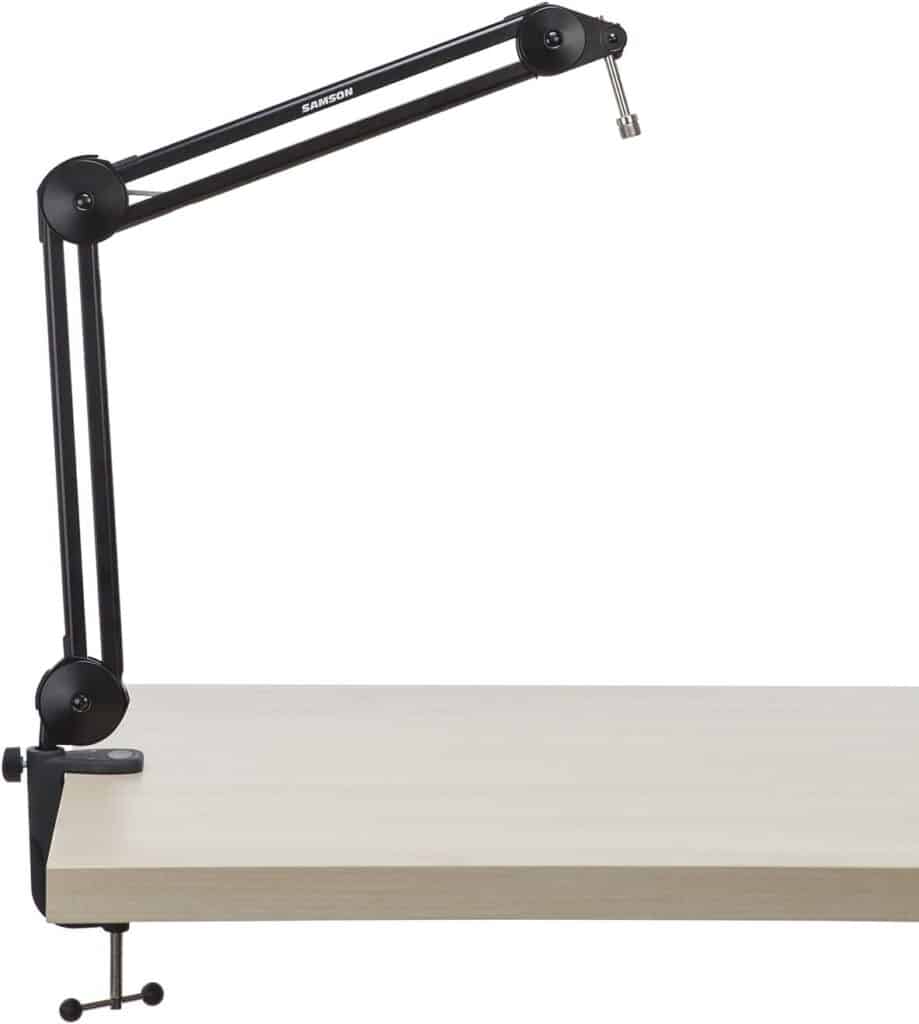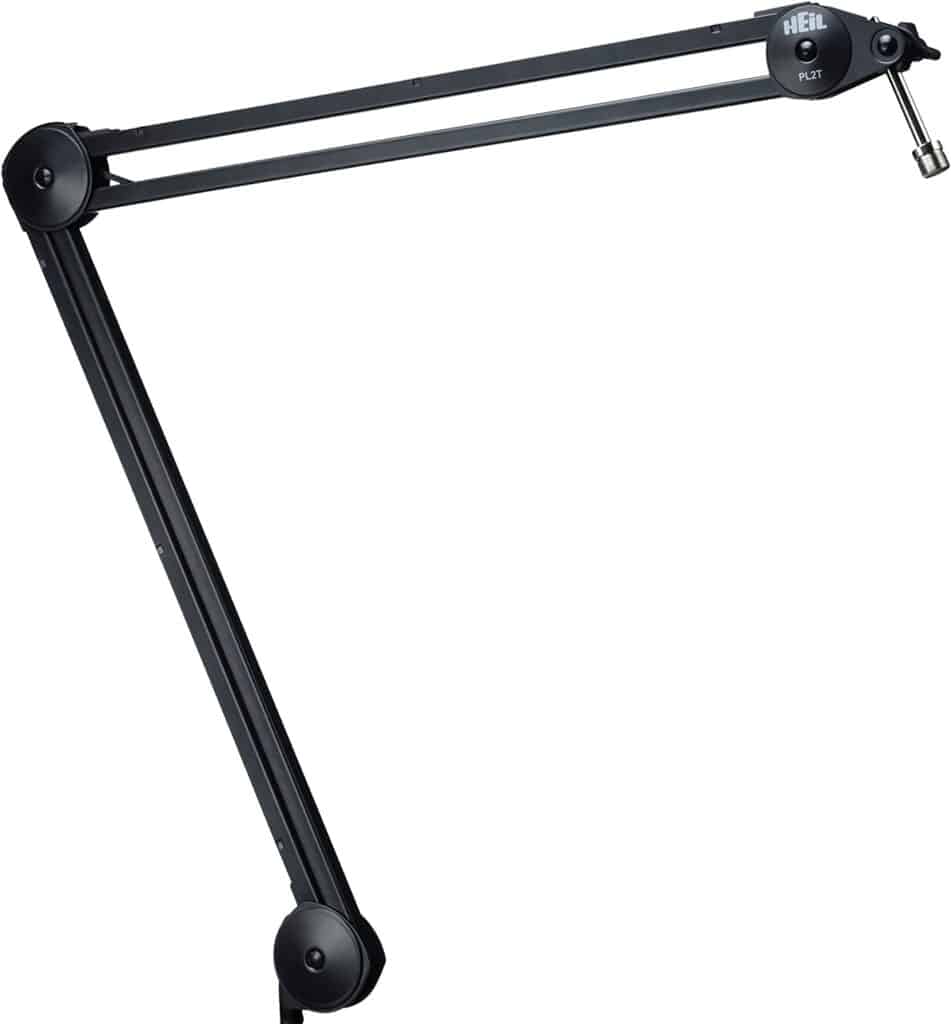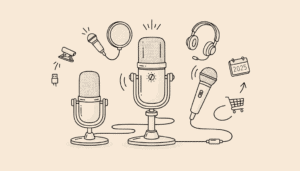Whether you’re a new or veteran podcaster having the right mic stand is crucial for getting the best sound quality. In this article post, we take a look at the best mic stands on the market and break down their features and benefits.
Castos is a participant in the Amazon Services LLC Associates Program. We may earn commissions from your purchases on Amazon.com, though at no cost to you.
Why You Need a Mic Stand
Overall, a mic stand can greatly enhance the quality and convenience of your recording or performance setup by providing a stable and adjustable way to position your microphone. Here are several benefits to using a mic stand.
Optimal microphone placement
A mic stand arm allows you to position your microphone at the optimal height and angle for capturing the best sound. This is especially important when recording vocals as it ensures that the sound waves are properly aligned with the diaphragm of the microphone.
Reduced handling noise
Holding a microphone in your hand can cause unwanted movement and handling noise, which can be picked up by the microphone and ruin a recording. A mic stand arm helps to eliminate this issue by providing a stable and secure way to hold the microphone.
Enhanced freedom of movement
Using a mic stand allows you to position the microphone closer to the sound source, which can be especially helpful when recording podcasts or streaming games. This gives you more freedom to move and interact with your audience without having to hold the microphone.
Increased convenience
A mic stand or boom arm can be especially useful when recording multiple people or instruments, as it allows you to position the microphone in the optimal spot for each person or instrument without having to hold the microphone yourself. This can save time and effort, especially when recording longer sessions.
Protection for your mic against falls
Microphones can be expensive and you can’t podcast without them, so it’s important to protect them from damage. Mic stands keep your microphones secure and away from your hands so they don’t tip over and fall off your desk.
The Different Kinds of Mic Stands
The type of mic stand you choose will depend on your specific needs and the intended use of the microphone. Whether you’re recording in a studio, performing on stage, or simply recording a podcast, there is a mic stand available that can help you achieve the best possible sound.
There are several types of mic stands available, each designed for specific uses and situations. Some common types include:
- Boom mic stands: These stands feature a long, adjustable arm that allows the microphone to be positioned closer to the sound source. They are ideal for recording or amplifying instruments or vocals in a studio or on stage.
- Straight mic stands: As the name suggests, these stands feature a straight, vertical pole that holds the microphone in place. They are often used in live performances or in situations where a boom stand is not practical.
- Desktop mic stands: These compact stands are designed to be placed on a flat surface, such as a desk or table. They are ideal for podcasting or other situations where a more portable mic stand is needed.
- Overhead mic stands: These stands are designed to hold microphones above the sound source, such as a choir or orchestra. They feature a horizontal bar that allows the microphone to be positioned over the group.
- Microphone clips: These are small, spring-loaded clips that attach to the microphone and hold it in place on a stand. They are often used in conjunction with boom or straight stands to secure the microphone in place.
- Shock mount mic stands: These stands feature a built-in shock mount, which helps to reduce vibrations and handling noise when recording. They are often used in studio recording situations to ensure the best possible sound quality.
The Best Mic Stands
Whether you’re in need of a portable stand for on-the-go performances or a sturdy option for your studio setup, we’ve got you covered. Let’s dive in and find the best mic stand for your needs!
1. On-Stage MS7701B Tripod Microphone Boom Stand
The OnStage MS7701B is a professional-grade mic stand that is perfect for both recording and live performances. It features a sturdy, black finish and a telescoping boom arm for easy adjustments and precise microphone placement.
The stand also has a weighted base that helps to keep it stable and prevents it from tipping over, and an easy-to-use twist-and-lock mechanism for adjusting the height. The MS7701B is well-made and reliable, making it an excellent choice for podcasters. It is also a great value for the price.
2. Gator Frameworks GFW-MIC-0821 Weighted Microphone Stand
The Gator Frameworks GFW-MIC-0821 is a versatile and high-quality mic stand that is perfect for a wide range of applications. It features a sleek, black finish and a telescoping boom arm for easy adjustments and precise microphone placement. The stand is also equipped with a unique, foldable tripod base that provides excellent stability and can be easily transported. The GFW-MIC-0821 is made with durable materials and is built to last.
3. On-Stage DS7200B Adjustable Desktop Microphone Stand
The On Stage DS7200B is a professional-grade desk stand that is perfect for podcasters, broadcasters, and anyone else who needs a stable and adjustable stand for their microphone. It features a sturdy, black finish and a clamp that allows it to be securely attached to a desk or tabletop. The stand also has a flexible gooseneck that allows for precise microphone placement, and a built-in pop filter that helps to reduce plosives and other unwanted sounds.
4. VIMVIP 3-in-1 Cell Phone & Microphone Stand
The VIMVIP 3-in-1 Cell Phone & Microphone Stand is a versatile and convenient tool for anyone who uses their phone or microphone for work or leisure. It features a sturdy, adjustable stand that can hold a phone, tablet, or microphone, making it perfect for video calls, streaming, recording, or simply hands-free viewing.
The stand also has a flexible gooseneck that allows for precise positioning and a stable base that keeps it in place. The 3-in-1 design makes it an excellent choice for anyone looking to save space and streamline their setup.
5. Heil Sound SB-2 Small Microphone Boom Arm
The Heil SB-2 is a hybrid between a full boom and a desk stand, sometimes referred to as a “stick boom.” It features a vice mount that can be attached to a desk, with a stand that fits into a hole in the top of the mount. This design allows the boom to rotate a full 360 degrees. Heil also offers more permanent wall and desk mounts that are compatible with the SB-2 and other boom arms, such as the PL-2T.
6. Rode DS1 Desktop Microphone Stand
The Rode DS1 is a compact and versatile tabletop microphone stand designed for podcast recording and live streaming. With its lightweight and portable design, the DS1 is perfect for use in the studio, on stage, or at home.
The stand features a stable, non-slip base that ensures your microphone stays in place. The adjustable boom arm allows you to position the microphone exactly where you need it, while the thread adapter fits most standard microphones. The Rode DS1 is an excellent choice for anyone looking for a reliable and high-quality tabletop mic stand.
7. Proline MS112 Desktop Boom Mic Stand
The Proline MS112 is a versatile mic stand that can be used on the floor or on a tabletop. It features a boom arm that adjusts from 1″ to 9″ and a height that can be adjusted from 12″ to 17″. This mic stand is ideal for recording podcasts, bass drums, amplifiers, and more.
It has been used on the Dan Patrick show and is known for its high-quality construction and stability. The stand also includes a cable clip to keep things organized and tidy. Whether you’re recording in a studio or on stage, the Proline MS112 is an excellent choice for anyone looking for a reliable mic stand.
8. Heil Sound CB-1 PTT Microphone Stand with Push-to-talk Button
The Heil Sound CB-1 PTT is a heavy and polished-chrome base mic stand that is specifically designed to work with the Heritage and other Heil Sound microphones. It features a “Soft Touch” push-to-talk (PTT) switch on the base that can be used as a “Cough Switch” in broadcast and other live sound applications.
The stand includes a 24″ jumper cable for connecting to the PTT control jack and has standard 5/8″ – 27 threading, which is compliant with industry standards. The base also includes a 2″ riser that sets the microphone at a comfortable height for use. Overall, it’s an excellent choice for anyone looking for a reliable and high-quality mic stand.
9. Samson MBA28 Microphone Boom Arm
The SAMSON MBA28 is a versatile and durable boom arm with a sleek, black finish and sturdy construction. It features a 28-inch reach, allowing you to position your equipment exactly where you need it. It also has a 360-degree rotation and a smooth, spring-loaded counterbalance system that makes it easy to adjust and hold in place. The MBA28 is compatible with most standard microphone stands, making it easy to integrate into any existing recording setup.
10. Heil Sound PL-2T Overhead Broadcast Boom
The Heil Sound PL-2T is a top-of-the-line boom arm designed for use in professional recording studios and broadcast facilities. With its durable construction and sleek, black finish, the PL-2T is a reliable and attractive choice for any recording setup.
It features a 32-inch reach, allowing you to position your equipment exactly where you need it. It also has a 360-degree rotation and counterbalance system for easy adjustments. The PL-2T comes with a variety of mounting options, including desk and wall mounts.
Mic Stand Frequently Asked Questions
We’ve covered the best mic stands for podcasting, but you may have some questions. Here are some frequently asked questions about mic stands.
What is the best mic stand for streamers?
Typically, streamers need a mic stand that clamps firmly to the desk and keeps cables tidy. Streaming mic stands should also sit out of the way so the streamer can access other items on the desk. Check out our equipment list for live streamers for more information.
What is the best mic stand for video creators?
There are a lot of good options, so it depends on your budget. Video creators should opt for a mic stand with a slim profile that can sit out of the video frame.
How much does a mic stand or boom arm cost?
As much as you want to spend. There is a wide variety of mic stands and boom arms, so you’re sure to find one that meets your needs and budget.
What is the point of a boom arm?
A boom arm serves the same purpose as a mic stand, but it can be attached to another surface so the mic is suspended in front of you without taking up table space. You can also slide them aside when not in use.
What is a microphone arm?
A microphone arm is a device that holds a microphone in place and allows it to be adjusted to different positions. It is often used to position a microphone in front of an instrument, speaker, or other sound source. Some are freestanding while others secure to a table or desk. “Mic stand” and “boom arm” are often used interchangeably.
What is a good microphone arm?
This depends on what you need in a mic stand or boom arm. Choose a mic stand or boom arm that fits your recording space (or is portable if you travel), works with your microphone, suits your personal ergonomics, and meets your budget.
How do I set my arm mic?
To set up a microphone arm, you will need to follow these steps:
- Install the arm onto your desk or other surface using the provided mounting hardware.
- Attach the microphone to the end of the arm using the appropriate adapter or mount.
- Adjust the position of the arm so that the microphone is pointed towards the sound source you want to capture.
- Make any necessary adjustments to the angle and height of the arm to get the desired placement of the microphone.
- Test the microphone to make sure it is picking up sound properly and adjust the position of the arm as needed.
It’s a good idea to experiment with different positions and angles to find the best sound quality and clarity. You may also need to adjust the settings on your audio recording software or device to ensure that the microphone is working properly.
Can you use any boom arm for any mic?
Technically, yes. Most mic boom arms have a universal thread that will attach to any standard-sized microphone.Most microphones, with a clip or shock mount that connects to the boom arm. However, some mics are larger than others and require larger boom arms that can accommodate their size and mounting style.
Are mic stands worth it?
Mic stands can be worth it depending on your needs and preferences. They give you flexibility by allowing you to adjust the height and angle of the microphone to get the best sound quality and clarity. Mic stands are typically lightweight and easy to transport, making them easy to set up and break down. They also provide a stable platform for the microphone than hand-held models, which can be prone to shaking or movement. This is especially important for recording high-quality audio.
What mic stand does Joe Rogan use?
Joe Rogan uses the Gator Frameworks Deluxe Desk-Mounted Broadcast Microphone Boom Stand. It’s easy to set up to start recording in minutes. It also offers a lot of flexibility so you can position it anywhere on your desk and it’s always within reach.
Should I put my mic on a boom arm?
It can be a good idea to use a boom arm to hold your microphone if you need to adjust the position of the microphone frequently or if you want to reduce handling noise. Boom arms are also useful for recording instruments or vocals as they allow you to position the microphone closer to the sound source. However, if you do not need to adjust the position of the microphone often or if you do not want to invest in additional equipment, a standard mic stand or a hand-held microphone may be sufficient.
